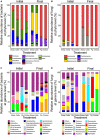Livestock Manure Type Affects Microbial Community Composition and Assembly During Composting
- PMID: 33828537
- PMCID: PMC8019744
- DOI: 10.3389/fmicb.2021.621126
Livestock Manure Type Affects Microbial Community Composition and Assembly During Composting
Abstract
Composting is an environmentally friendly way to turn plant and animal wastes into organic fertilizers. However, it is unclear to what extent the source of animal waste products (such as manure) affects the physicochemical and microbiological properties of compost. Here, we experimentally tested how the type of livestock manure of herbivores (sheep and cattle) and omnivores (pig and chicken) influences the bacterial and fungal communities and physicochemical properties of compost. Higher pH, NO3-N, Total carbon (TC) content and C/N were found in sheep and cattle manure composts, while higher EC, NH4-N, Total nitrogen (TN) and total phosphorus (TP) content were measured in pig and chicken manure composts. Paired clustering between herbivore and omnivore manure compost metataxonomy composition was also observed at both initial and final phases of composting. Despite this clear clustering, all communities changed drastically during the composting leading to reduced bacterial and fungal diversity and large shifts in community composition and species dominance. While Proteobacteria and Chloroflexi were the major phyla in sheep and cattle manure composts, Firmicutes dominated in pig and chicken manure composts. Together, our results indicate that feeding habits of livestock can determine the biochemical and biological properties of manures, having predictable effects on microbial community composition and assembly during composting. Manure metataxonomy profiles could thus potentially be used to steer and manage composting processes.
Keywords: composting; feeding habit; livestock manures; microbial community; physicochemical properties.
Copyright © 2021 Wan, Wang, Yang, Wei, Banerjee, Friman, Mei, Xu and Shen.
Conflict of interest statement
The authors declare that the research was conducted in the absence of any commercial or financial relationships that could be construed as a potential conflict of interest.
Figures




Similar articles
-
Phytotoxicity of farm livestock manures in facultative heap composting using the seed germination index as indicator.Ecotoxicol Environ Saf. 2022 Dec 1;247:114251. doi: 10.1016/j.ecoenv.2022.114251. Epub 2022 Oct 31. Ecotoxicol Environ Saf. 2022. PMID: 36327785
-
Difference responses of soil fungal communities to cattle and chicken manure composting application.J Appl Microbiol. 2022 Aug;133(2):323-339. doi: 10.1111/jam.15549. Epub 2022 Apr 13. J Appl Microbiol. 2022. PMID: 35338761
-
[Influence of the Composition of the Initial Mixtures on the Physicochemical and Biological Properties and Spectral Characteristics of Composts].Guang Pu Xue Yu Guang Pu Fen Xi. 2015 Aug;35(8):2268-74. Guang Pu Xue Yu Guang Pu Fen Xi. 2015. PMID: 26672307 Chinese.
-
Composting of animal manures and chemical criteria for compost maturity assessment. A review.Bioresour Technol. 2009 Nov;100(22):5444-53. doi: 10.1016/j.biortech.2008.11.027. Epub 2008 Dec 31. Bioresour Technol. 2009. PMID: 19119002 Review.
-
Trends in the management of organic swine farm waste by composting: A systematic review.Heliyon. 2023 Jul 14;9(8):e18208. doi: 10.1016/j.heliyon.2023.e18208. eCollection 2023 Aug. Heliyon. 2023. PMID: 37576302 Free PMC article. Review.
Cited by
-
Compositional and Functional Changes in Microbial Communities of Composts Due to the Composting-Related Factors and the Presence of Listeria monocytogenes.Microbiol Spectr. 2022 Aug 31;10(4):e0184521. doi: 10.1128/spectrum.01845-21. Epub 2022 Jun 15. Microbiol Spectr. 2022. PMID: 35703536 Free PMC article.
-
Effects of compost as a soil amendment on bacterial community diversity in saline-alkali soil.Front Microbiol. 2023 Sep 27;14:1253415. doi: 10.3389/fmicb.2023.1253415. eCollection 2023. Front Microbiol. 2023. PMID: 37829448 Free PMC article.
-
Dynamics of microbial functional guilds involved in the humification process during aerobic composting of chicken manure on an industrial scale.Environ Sci Pollut Res Int. 2024 Mar;31(14):21044-21056. doi: 10.1007/s11356-024-32390-2. Epub 2024 Feb 21. Environ Sci Pollut Res Int. 2024. PMID: 38381293
-
Metagenomic investigation reveals bacteriophage-mediated horizontal transfer of antibiotic resistance genes in microbial communities of an organic agricultural ecosystem.Microbiol Spectr. 2023 Oct 17;11(5):e0022623. doi: 10.1128/spectrum.00226-23. Epub 2023 Sep 27. Microbiol Spectr. 2023. PMID: 37754684 Free PMC article.
-
Effects of Turning Frequency on Ammonia Emission during the Composting of Chicken Manure and Soybean Straw.Molecules. 2022 Jan 12;27(2):472. doi: 10.3390/molecules27020472. Molecules. 2022. PMID: 35056787 Free PMC article.
References
-
- Arif M. S., Riaz M., Shahzad S. M., Yasmeen T., Ali S., Akhtar M. J. (2017). Phosphorus-mobilizing rhizobacterial strain Bacillus cereus GS6 improves symbiotic efficiency of soybean on an aridisol amended with phosphorus-enriched compost. Pedosphere 27 1049–1061. 10.1016/S1002-0160(17)60366-7 - DOI
-
- Awasthi M. K., Chen H. Y., Liu T., Awasthi S. K., Wang Q., Ren X. N., et al. (2019). Respond of clay amendment in chicken manure composts to understand the antibiotic resistant bacterial diversity and its correlation with physicochemical parameters. J. Cleaner Product. 236:117715. 10.1016/j.jclepro.2019.117715 - DOI
-
- Awasthi M. K., Zhang Z. Q., Wang Q., Shen F., Li R. H., Li D. S., et al. (2017). New insight with the effects of biochar amendment on bacterial diversity as indicators of biomarkers support the thermophilic phase during sewage sludge composting. Bioresour. Technol. 238 589–601. 10.1016/j.biortech.2017.04.100 - DOI - PubMed
LinkOut - more resources
Full Text Sources
Other Literature Sources

